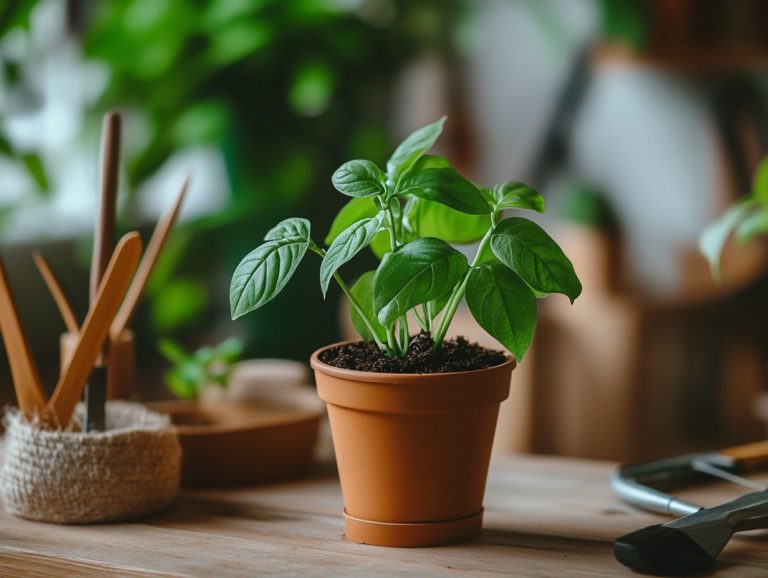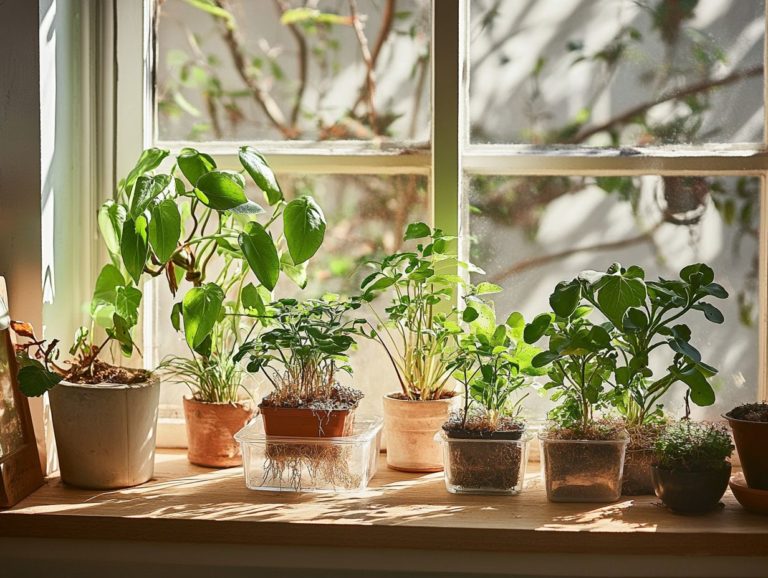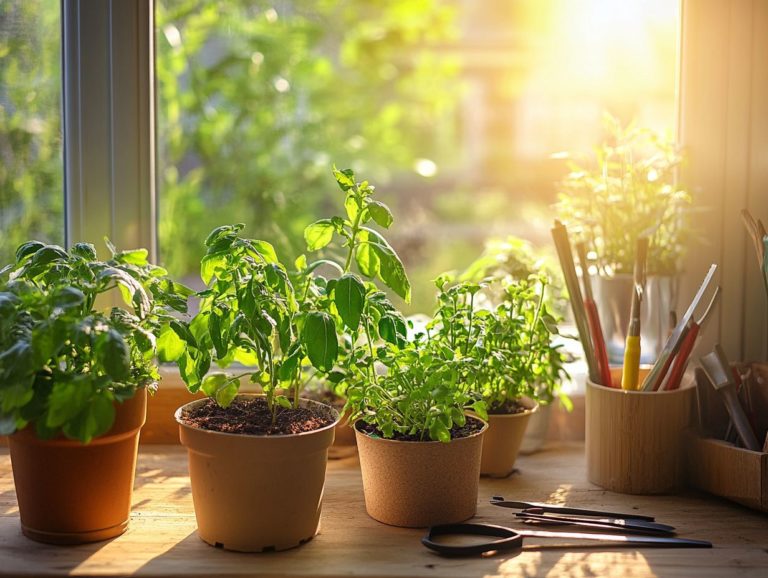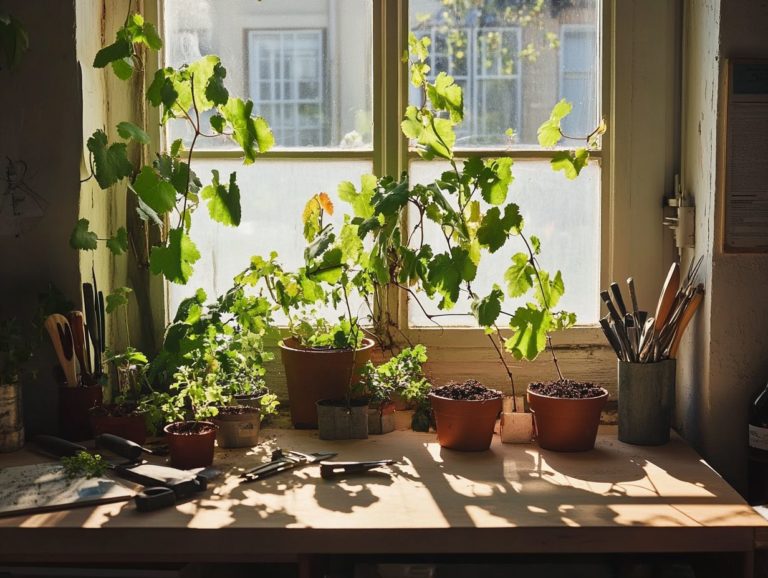The Benefits of Propagating Your Own Plants
Plant propagation is more than a gardening technique. It s a rewarding way to grow new life from your favorite plants.
Whether you want to save money, ensure the quality of your greenery, or positively impact the environment, propagating your own plants offers many benefits.
This article explores various methods of plant propagation, from seeds to cuttings, and provides practical tips to help you succeed.
Get ready to unlock the secrets of nurturing your plant collection!
Contents
- Key Takeaways:
- Reasons for Propagating Your Own Plants
- Methods of Plant Propagation
- Tips for Successful Plant Propagation
- Frequently Asked Questions
- What are the benefits of propagating your own plants?
- Is propagating your own plants difficult?
- What are some ways to propagate plants?
- What are the benefits of stem cuttings?
- Why is propagating your own plants better than buying them?
- Are there any benefits to the environment when propagating your own plants?
Key Takeaways:

- Save money by propagating your own plants instead of buying them from a store.
- Have control over the quality of your plants by propagating them yourself.
- Contribute to a more sustainable environment through your plant propagation efforts.
What is Plant Propagation?
Plant propagation is the art of creating new plants from existing ones. It s a rewarding endeavor that nurtures a sustainable plant culture and deepens your connection with nature.
Whether you re taking cuttings from your cherished monstera or propagating flavorful herbs like basil and thyme, the methods you choose significantly affect the vitality of your new plants.
By mastering propagation techniques, such as using root nodes and ensuring clean water, you can cultivate a wide variety of houseplants or garden species that enhance your living space.
Understanding techniques like division, layering, and seed germination is essential for anyone eager to strengthen their bond with their green companions. For example, dividing perennials like hostas not only revitalizes their growth but also expands your garden.
Seed propagation opens doors to rare and unique plant varieties. The benefits extend beyond aesthetics; thriving plants contribute to improved air quality and biodiversity.
As you dive into plant care and sustainability practices, you ll enrich your surroundings and nurture a deep sense of responsibility toward the environment.
Reasons for Propagating Your Own Plants
Cultivating your own plants provides numerous advantages that elevate both your gardening experience and your living space. It transforms gardening into a rewarding and economical pursuit that champions sustainable plant production.
Imagine the significant cost savings from propagating new plants at home, along with the confidence of having complete control over the quality and health of your treasured houseplants. This practice enhances your garden’s vibrancy and positively impacts the environment by reducing reliance on commercially produced plants. To learn more about this rewarding process, explore the fascinating world of plant propagation.
Cost Savings
One major motivation for gardening enthusiasts is the substantial cost savings that come with propagating plants at home. This allows you to grow a diverse range of new plants without the hefty price tag of purchasing them from a nursery.
By mastering effective propagation techniques, you can cultivate an endless supply of greenery, transforming your garden into a lush paradise while enjoying the satisfaction of a frugal hobby.
This practice saves you money and fosters a deeper connection with nature. Popular choices like pothos, spider plants, and succulents are easy to propagate. Simply snip a cutting, place it in water, and watch it develop roots before replanting it in soil.
This continuous cycle of growth fills your space with vibrant greenery, bringing you joy and fulfillment. It enhances your overall gardening experience and promotes a flourishing, budget-friendly lifestyle.
Control over Plant Quality
When you propagate your own plants, you take charge of the quality. Each new plant can mirror the vibrant characteristics and lush leaves of its parent.
This gives you the power to select only the finest specimens for propagation. As a result, you create thriving plants that meet your gardening standards.
Carefully choose parent plants that show desirable traits like robust growth and pest resistance. Monitor their environment by providing proper watering, sunlight, and suitable soil.
Using techniques like cuttings or layering while keeping hygiene in mind helps prevent diseases. This commitment not only boosts your garden’s beauty but also fosters a thriving environment.
Environmental Benefits
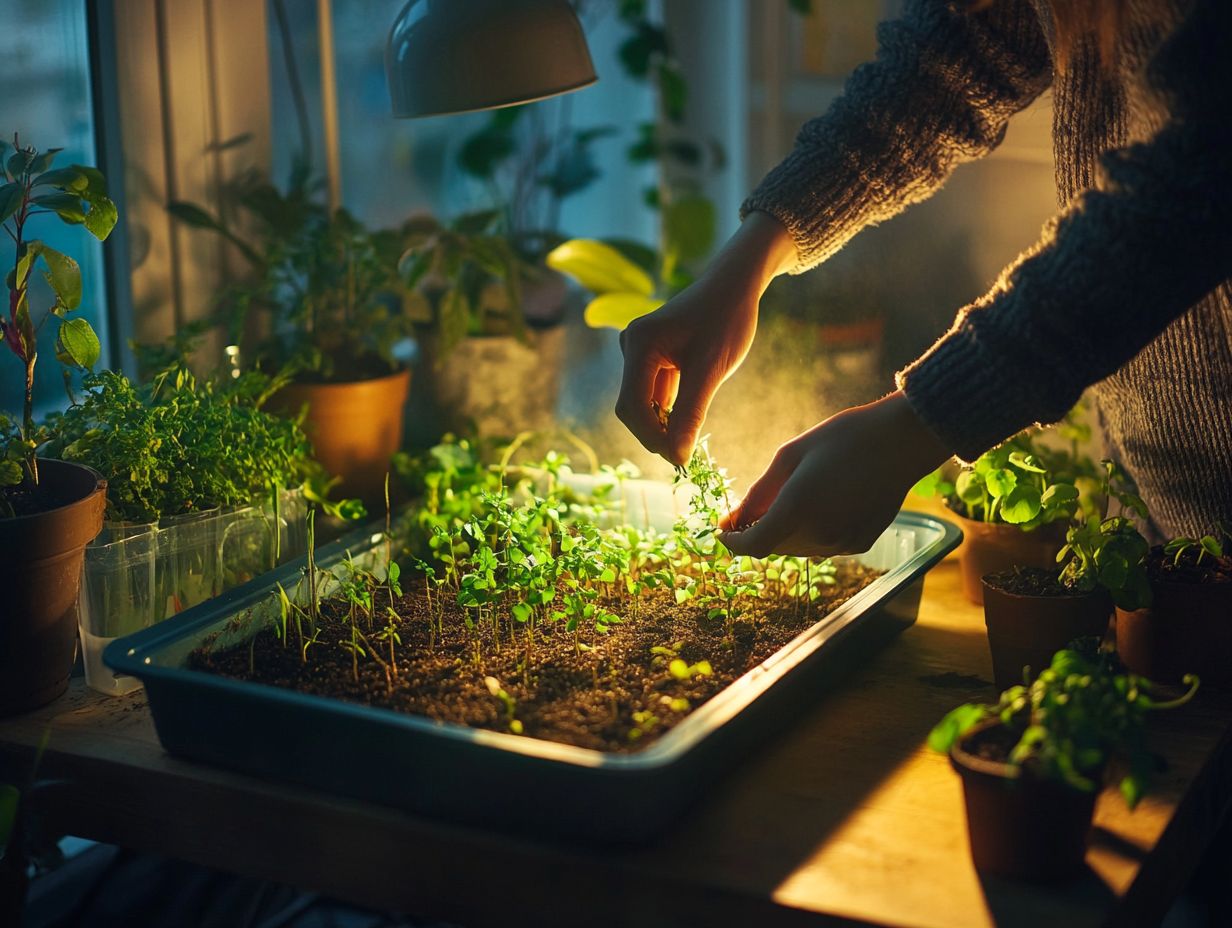
Propagating your own plants offers remarkable environmental benefits. It enhances sustainable plant production and helps tackle plant extinction by fostering biodiversity.
By cultivating a variety of plants like snake plants and spider plants you beautify your space and contribute to a healthier ecosystem. This practice encourages the growth of native species, which are crucial for ecological balance.
Engaging in plant propagation reduces reliance on commercial nurseries, which can lead to overharvesting and habitat destruction. Whether you start from seeds or cuttings, this eco-friendly endeavor nurtures your connection with nature.
Share your propagated plants with friends and neighbors to spread the message of environmental stewardship!
Methods of Plant Propagation
You have various effective methods of plant propagation at your fingertips. Each method has unique advantages tailored to different plant types and personal preferences.
Choose to take cuttings, try seed propagation, or explore division propagation. These techniques allow you to expand your collection of houseplants or nurture herbs like rosemary and mint.
Embrace this enjoyable process to elevate your gardening experience!
Seed Propagation
Seed propagation is a natural and rewarding way to cultivate new plants. Germinating seeds from your favorite herbs like basil, thyme, and coriander opens the door to a diverse array of plants.
This technique lets you witness the entire growth cycle from seed to mature plant. Choosing quality seeds is crucial for your success, so consider selecting organic or heirloom varieties.
Provide optimal growing conditions, like the right soil, moisture, and light to boost germination rates. Using seed trays or pots makes it easier to monitor growth.
Keep up with regular watering and nutrient management to nurture your flourishing seedlings!
Cutting Propagation
Cutting propagation is a popular gardening method. You take cuttings from a parent plant and nurture them until they grow roots and develop into new plants. Establishing a dedicated propagation station can streamline this process, allowing you to monitor and care for your cuttings with ease.
By creating the best environment for growth, you can significantly boost your chances of successful rooting. Typically, semi-hardwood or softwood cuttings yield the best results, with popular options including geraniums, philodendrons, and rosemary.
It s crucial to use clean, sharp tools when taking your cuttings to prevent any risk of disease. After cutting, place them in a suitable rooting medium like perlite or a blend of peat and vermiculite to enhance moisture retention and aeration, setting the stage for success.
Covering your cuttings with a humidity cover can further support their growth, creating a mini-greenhouse effect that encourages root development. With regular misting and the right light exposure, you ll soon have healthy new plants ready for transplanting.
Division Propagation
Division propagation involves the artful separation of a healthy plant into several sections, each with its own root system. This technique is a game-changer for multiplying your beloved houseplants, such as Swiss ivy and snake plants. Not only does it ensure the vitality of your plants, but it also champions sustainable plant production by enabling you to propagate existing specimens with ease.
Timing plays a pivotal role in achieving successful division, ideally during the plant’s active growing season, typically in spring or early summer. When tending to your plant, gently extract it from its pot to minimize any damage to the roots. Use sharp, clean tools to make precise cuts, ensuring that each division has several healthy leaves alongside a substantial portion of the root system to thrive.
This sustainable practice elevates the aesthetic of your garden while simultaneously bolstering biodiversity, positively influencing the overall health of both indoor and outdoor environments.
Tips for Successful Plant Propagation
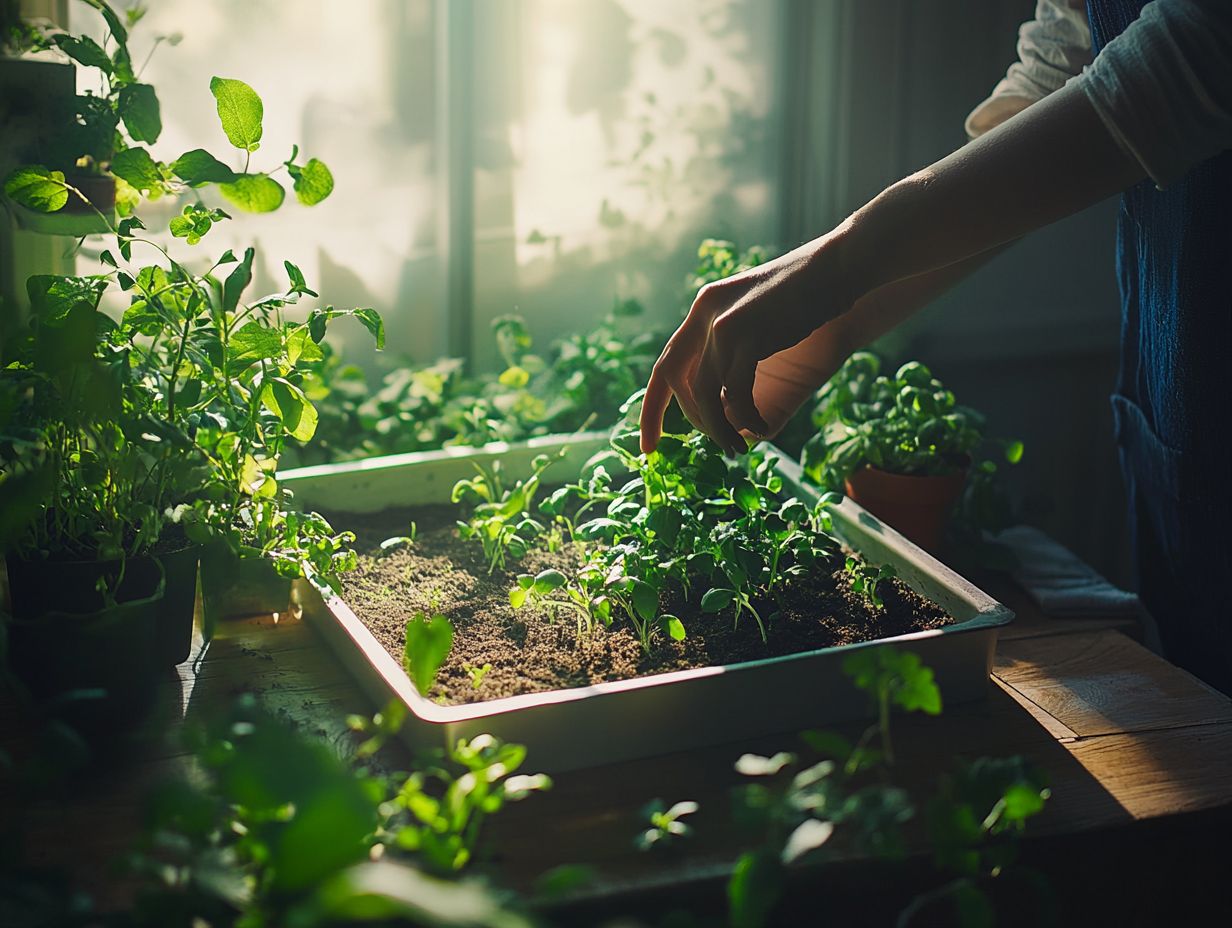
Want to succeed in plant propagation? Use the right techniques and choose the best plants to make your gardening dreams come true!
By understanding the specific needs of your chosen varieties, whether herbs like rosemary or decorative houseplants like pothos, you can provide the nurturing care they require to truly flourish.
Choosing the Right Plants
Choosing the right plants for propagation is essential for ensuring your efforts lead to success, whether you re focusing on popular houseplants or outdoor varieties. Consider factors like growth habits, ease of propagation, and overall health as your guiding stars in this selection process.
Specifically, seek out species renowned for their ability to thrive from cuttings think pothos, succulents, and geraniums. If you re feeling adventurous, consider plants that flourish when propagated from seeds, such as sunflowers and zinnias; they make excellent choices for any gardener eager to explore diverse methods. Don’t overlook plants that can be divided, like hostas and daylilies. This technique not only yields multiple new plants but also ensures the parent specimen remains healthy.
By thoughtfully evaluating these criteria, you can create a diverse garden that bursts with vitality and beauty.
Proper Techniques and Tools
Utilizing proper techniques and tools is essential for effective plant growing. These can significantly influence the health and growth of your new plants. Ensure you have clean water for root development. Use sharp tools for taking cuttings, as these details can make a substantial difference in your success.
Employing sterile pots and seedling trays is crucial for preventing diseases that could jeopardize your delicate seedlings. Adjusting humidity levels with domes can promote healthier growth. Misting your cuttings helps maintain moisture during their initial stages.
Don’t forget to regularly clean your tools! This prevents contamination and helps your plants thrive, limiting the potential for diseases to spread. To further enhance your propagation environment, consider utilizing grow lights, especially if natural sunlight falls short.
By paying attention to these essential practices, you can foster a thriving propagation process, leading to bountiful plants.
Nurturing and Care
Nurturing and caring for your newly propagated plants is essential for developing strong, healthy leaves and robust root systems. This creates the optimal environment for their growth. Implement suitable watering techniques, manage light exposure, and control humidity to lay the foundation for your plants to truly thrive.
Understanding the delicate balance of moisture is crucial. Overwatering can lead to root rot, a condition where roots decay due to excess water. On the other hand, underwatering may stunt their growth. Providing bright, indirect sunlight is often ideal. This allows young plants to absorb energy without the risk of scorching.
Maintaining a suitable indoor temperature and humidity level can significantly impact their development. Utilizing humidity trays or misting mimics their native environments, fostering a more conducive atmosphere for establishment. This holistic approach not only encourages robust growth but also equips your plants to face future challenges with confidence.
Frequently Asked Questions
Have questions about plant propagation? Here are some common queries answered!
What are the benefits of propagating your own plants?
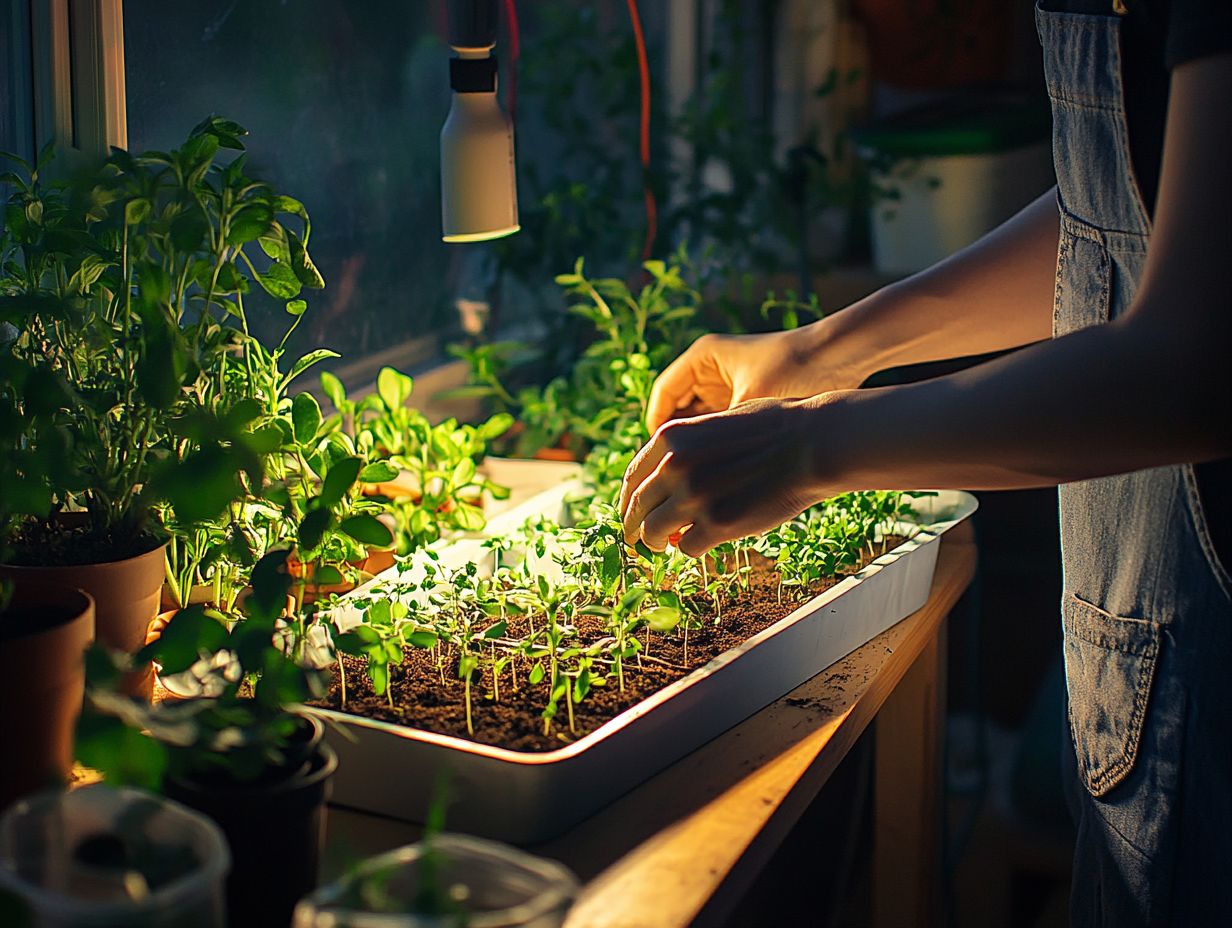
Propagating your own plants allows you to create an endless supply of new plants without spending money on buying them. It also lets you experiment with different propagation methods and grow a wider variety of plants in your garden.
Is propagating your own plants difficult?
Not at all! Propagating plants can be a fun and easy way to expand your garden. With a few simple techniques and proper care, anyone can successfully propagate their own plants.
What are some ways to propagate plants?
Several methods exist for propagating plants, including:
- Stem cuttings
- Leaf cuttings
- Division
- Layering
- Seed propagation
Each method has unique benefits and works best for different types of plants.
What are the benefits of stem cuttings?
Stem cuttings are a quick and easy way to propagate plants. They can root quickly and produce a new plant in just a few weeks, allowing you to create clones of your favorite plants.
Why is propagating your own plants better than buying them?
Propagating your own plants is more cost-effective and gives you control over the quality and health. You can ensure they are free from pesticides and harmful chemicals, making them healthier for you and the environment.
Are there any benefits to the environment when propagating your own plants?
Yes! Propagating your own plants can positively impact the environment. By growing your own plants, you reduce the demand for commercially grown plants that often require harmful chemicals. Additionally, propagating plants helps preserve rare and endangered species by creating new plants from existing ones.

